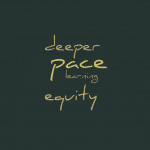Navigating the Nuances of Competency Education (Part 2)
CompetencyWorks Blog
 In the opening article, I argue that instead of thinking about competing definitions of competency-based education or personalized learning, we should approach them as different emphases. Our job then is to note the different emphasis, understand its core ideas and rationale, and then discover together if there are commonalities or perhaps gaps in understanding. Let’s start with competency-based education.
In the opening article, I argue that instead of thinking about competing definitions of competency-based education or personalized learning, we should approach them as different emphases. Our job then is to note the different emphasis, understand its core ideas and rationale, and then discover together if there are commonalities or perhaps gaps in understanding. Let’s start with competency-based education.
I’ve encountered four different ways that competency-based education is discussed:
Equity: There are those who see it as a re-design of the traditional system, drawing on the best of what we know from research and practice, to create a more equitable education system. The emphasis on competency is that the school commits to making sure every learner will reach proficiency or become competent in all the types of learning expectations. It has a strong emphasis on re-designing the structural system, rooting out institutional racism, and engaging in practices to rid ourselves of bias. It is highly related to learning centeredness below. The revised paper on equity in competency education will be released in the next couple of months.
Learning Centeredness: This orientation emphasizes putting learning in the center for both students and adults. The people who emphasize this are also emphasizing distributed leadership, learning sciences, doing what is best for kids, and continuous improvement. It’s best captured by the “doing what is best for kids” mantra. I’ve also heard this described as “competency-based education is primarily a system of continuous improvement in that it creates a closed system rather than one in which students get passed on, pushed out, and left behind.” Ty Cesene captures this spirit with, “We aren’t done innovating until 100 percent of our students are graduating.” Shared by equity advocates, the folks in the learning-centered wheelhouse believe that we need to keep learning, innovating, and reiterating until we figure out how to get all kids to proficiency.
Deeper Learning: I think it is most helpful to think about this as driven by outcomes that students should have so-called “21st century skills.” There are many in the world of competency-based education who are working hard to lift up the education system from a world of rote memorization and assessment by test to that of deeper learning, including application of skills, development of higher order skills, and performance-based assessments. This emphasis requires attention to re-aligning the system of instruction and assessment around competencies that require students to be able to transfer skills to new contexts (whereas learning a standard doesn’t have the expectation of students actually being able to use it). This group feels strongly that districts and schools have to embrace powerful competencies that go beyond academic knowledge and skills that are meaningful to students and their future. The competencies should be the focus of the systems of assessments with standards as bite-sized steps that help students reach the competencies.
Pace: Pace matters in competency-based schools. Competency-based schools are hopefully focusing on student growth and monitoring pace or the rate of growth as a very important part of that. So is coaching students in the habits of success that can help them stay “on pace” toward graduation. However, many of the folks who jump onto competency-based education are referring to the use of technology. Just about every concept gets swallowed by the black hold of ed tech vendors. A powerful systemic change like competency-based education gets swallowed and spit back as pace and self-directed learning. Personalization, a societal shift in how we understand children and learning, gets shrunk down to everyone on an individual path in a software program. Yes, students having control over the tempo of their learning is important. However, the really important thing is to help students take charge of their education through coaching them to build a growth mindset, learn about metacognition, and develop self-regulation skills.
To bring this point home, competency-based education has all four of these purposes and features. If you only focus on equity or learning-centeredness, its possible we could end up with a system that has all students successful…in rote learning and comprehension but with no ability to apply it. If you only focus on deeper learning and don’t think about equity, it’s likely that you are going to still see the same patterns of privileging white and higher income kids to get a better education than students of color from low-income communities. And if you only focus on students having flexible pacing without putting into place all the structures to make sure they are getting timely and differentiated supports that ensure students master the skills, you really are at risk that you are going to leave a lot of students behind.
I’m trying to shift my orientation to think about these changes as developmental with every district and schools starting somewhere, taking some big steps, and then taking some more. And I’ll trust that someone will call me out if I get snappy and judgy.
See also: